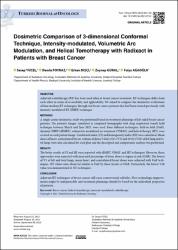| dc.contributor.author | Yücel, Serap | |
| dc.contributor.author | Poyraz, Damla | |
| dc.contributor.author | Dişçi, Erhan | |
| dc.contributor.author | Güral, Zeynep | |
| dc.contributor.author | Ağaoğlu, Fulya | |
| dc.date.accessioned | 2023-12-19T06:15:30Z | |
| dc.date.available | 2023-12-19T06:15:30Z | |
| dc.date.issued | 2023 | en_US |
| dc.identifier.citation | Yücel, S., Poyraz, D., Dişçi, E., Güral, Z. ve Ağaoğlu, F. (2023). Dosimetric comparison of 3-dimensional conformal technique, intensity-modulated, volumetric arc modulation, and helical tomotherapy with radixact in patients with breast cancer. Turkish Journal of Oncology, 38(4), 444-450. https://dx.doi.org/10.5505/tjo.2023.4152 | en_US |
| dc.identifier.issn | 1300-7467 | |
| dc.identifier.uri | https://dx.doi.org/10.5505/tjo.2023.4152 | |
| dc.identifier.uri | https://hdl.handle.net/20.500.12511/12024 | |
| dc.description.abstract | OBJECTIVE Adjuvant radiotherapy (RT) has been used often at breast cancer treatment. RT techniques differ from each other in terms of accessibility and applicability. We aimed to compare the dosimetric evaluations of four modern RT techniques through ten breast cancer patients that had been treated previously with intensity-modulated RT (IMRT) technique. METHODS A single-center dosimetric study was performed based on treatment plannings of left-sided breast cancer patients. The patient’s images, simulated at computed tomography with deep inspiration breath hold technique between March and June 2023, were used. Four different techniques, field-in-field (FinF), dynamic IMRT (dIMRT), volumetric modulated arc treatment (VMAT), and helical therapy (HT) were created on each patient image. Conformal index (CI) and homogeneity index (HI) were calculated. Mean doses of heart, contralateral breast, volume of doses 5 Grey (Gy) (V5) and 10 Gy (V10) of left lung and total lungs were also calculated for each plan and the descripted and comparisons analysis was performed. RESULTS The better results of CI and HI were reported with dIMRT, VMAT, and HT techniques. However, these approaches were expected with increased percentage of lower doses at organs at risk (OAR). The lowest of V5 of left and total lungs, mean heart, and contralateral breast doses were achieved with FinF tech-niques, HT values were observed similar to FinF by these factors at OAR. Particularly, the lowest V20 value was demonstrated at HT techniques. CONCLUSION Adjuvant RT techniques at breast cancer still carry controversial subtitles. New technologic improvements might be indispensable and treatment plannings should be based on the individual properties of patients. | en_US |
| dc.language.iso | eng | en_US |
| dc.publisher | Kare Publishing | en_US |
| dc.rights | info:eu-repo/semantics/openAccess | en_US |
| dc.rights | Attribution-NonCommercial 4.0 International | * |
| dc.rights.uri | https://creativecommons.org/licenses/by-nc/4.0/deed.en | * |
| dc.subject | Breast Cancer | en_US |
| dc.subject | Helical Tomotherapy | en_US |
| dc.subject | Intensity-Modulated | en_US |
| dc.subject | Radiotherapy | en_US |
| dc.title | Dosimetric comparison of 3-dimensional conformal technique, intensity-modulated, volumetric arc modulation, and helical tomotherapy with radixact in patients with breast cancer | en_US |
| dc.type | article | en_US |
| dc.relation.ispartof | Turkish Journal of Oncology | en_US |
| dc.department | İstanbul Medipol Üniversitesi, Sağlık Bilimleri Enstitüsü, Sağlık Fiziği Ana Bilim Dalı | en_US |
| dc.authorid | 0009-0006-0992-4690 | en_US |
| dc.authorid | 0000-0002-7857-5045 | en_US |
| dc.identifier.volume | 38 | en_US |
| dc.identifier.issue | 4 | en_US |
| dc.identifier.startpage | 444 | en_US |
| dc.identifier.endpage | 450 | en_US |
| dc.relation.publicationcategory | Makale - Uluslararası Hakemli Dergi - Kurum Öğretim Elemanı | en_US |
| dc.identifier.doi | 10.5505/tjo.2023.4152 | en_US |
| dc.institutionauthor | Poyraz, Damla | |
| dc.institutionauthor | Dişçi, Erhan | |
| dc.identifier.wos | 001071757200001 | en_US |
| dc.identifier.scopus | 2-s2.0-85178944236 | en_US |
| dc.identifier.scopusquality | Q4 | en_US |



















